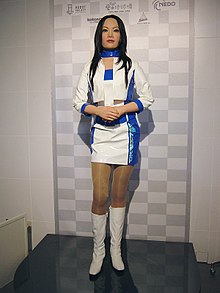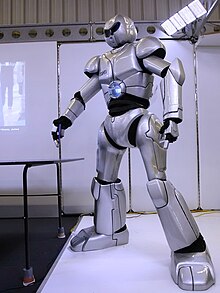人型机器人

人型机器人(英语:android),又称仿生人,音译安卓[1],是一种旨在模仿人类外观和行为的机器人(robot)[2][3][4][5],尤其特指具有和人类相似肌体的种类。[3] 直到最近,人型机器人的概念还主要停留在科学幻想领域,常见于电影、电视、漫画、小说等。机器人学方面的进展已经可以设计出功能化拟真化的人形机器人。[6]
仿生人拟真的程度有很多,有些可以从外观上识别,也没有真人的思想和感情。反过来说亦有开发外观不似人,但能够有似真人行为的机器人,如2001年美国麻省理工学院研发了号称世界上第一个有类似人类感情的机器人。
语源
[编辑]Android一词,源自希腊语词根andro-(人、男性)和后缀-oid(形似的)两者组合而来。鉴于“andro-”具有男性的意味,一些作品中将女性android称为Gynoid以示区别。
牛津英语词典中将这个词的最早使用追溯到1728年Ephraim Chambers所编撰的《百科全书》(这本书是以英文编撰的最早的百科全书之一),是关于一种据称是艾尔伯图斯·麦格努斯(约1200年-1280年)制作的自动机。[4][7]
Android这个术语早在1863年就出现在美国专利文献中,指代小型的人形玩具自动机。[8] Android这个术语更具现代意义的用法出现在法国作家维利耶·德·利尔-阿达姆的小说《未来夏娃》(1886年),[4]小说描述了一种人造的女性机器人。 自杰克·威廉森的《The Cometeers》(1936年) 开始,android这个术语很大程度上影响了英文科幻杂志《pulp杂志》。 而机械感的机器人(robot)和肉感的人型机器人(android)之间的差异则由Edmond Hamilton的《未来舰长》(1940–1944年)普及开来。[4]
项目
[编辑]日本
[编辑]自1970年代以来,日本的机器人技术就一直引领这一领域[9]。早稻田大学于1967年启动了WABOT项目,并于1972年完成了WABOT-1,这是第一个仿生人,一种全尺寸人形智慧机器人[10][11]。它的肢体控制系统允许它与下肢一起行走,并使用触觉传感器用手抓住和运输物体。它的视觉系统使它可以使用外部接收器、人造眼睛和耳朵来测量到物体的距离和方向,它的对话系统使它可以透过人工嘴以日语与人交流[11][12][13]。
1984年,WABOT-2问世,并进行了许多改良,有10根手指和2只脚,能够演奏风琴,并且能够阅读乐谱,还可以陪伴一个人[14]。1986年,本田技研工业开始进行人形机器人研发计划,以创造能够与人成功交互的人形机器人。[15]
由大阪大学石黑浩史教授领导的智慧机器人实验室和Kokoro Co. Ltd.在日本爱知县2005年世博会上展示了Actroid,并于2010年发布了Telenoid R1。2006年,Kokoro Co.开发了新的DER 2 android,其人体部分高165厘米,有47个可移动的接点,它不仅可以改变其表情,而且可以移动其手和脚并扭转其身体。
影剧、漫画、动画与游戏中的例子
[编辑]作品以书名号标示,角色名以粗体标示
- 电影/电视剧:
- 动画/漫画/游戏:
- 《Chobits》
- Data
- 《IS〈Infinite Stratos〉》
- Penny Polendina
- 《可塑性记忆》
- 《没有心跳的少女 BEATLESS》
- 《底特律:变人》
- 《娜罗的名单》
- 《夏娃的时间》
- 《假面骑士ZERO-ONE》
- 《HUG! 光之美少女》
- 《铳梦》
- 《钢铁天使》
- 《洛克人系列》
- 《尼尔:自动人形》
- 《少女前线》
- 《Vivy -Fluorite Eye's Song-》
- 《七龙珠》
- 《电脑奇侠》
- 《原子小金刚》
- 《奇异贤伴 黑色天使》
- 《AI电子基因》
- 《我与机器子》
- 《机械女仆》
- 《亚托莉 -我挚爱的时光-》
近义词/相关词
[编辑]Actroid
[编辑]表演机器人(日语:アクトロイド)。Actroid是将actor(演员)和android组合而成的合成词。目前特指日本大阪大学和Kokoro公司开发的一种外观上非常形似人类的仿生人。初展于2003年东京国际机器人展。随后又开发出多种不同版本。她可以模拟眨眼、说话、呼吸等似人行为。这种Repliee系列的交互式仿生人具有识别和处理语言并且作出回应的能力。
Cyborg与Bioroid
[编辑]赛博格(Cyborg,即Cybernetic Organism的略称),是把控制技术融入生物体(不一定是人类)而制造的科学幻想生物,即生物思考、机器身体的科学生命体。现在主要指代用人工无机结构对人类或者动物的身体进行强化而成的科幻生命体。
生物机器人。是使用一种真人或生物的活组织,但以机器为主体的类型,是和改造人(Cyborg)有重叠的概念,也是完全刻意为了仿冒真人而制造的,但行为不一定似真人,如电影《魔鬼终结者》的T系列和《西部世界》中的机器人。

人型机器人、拟人机器人。Humanoid意即类人的、似人的。可以大小和真人差很远也没有似人的外观,但有人的四肢和头等构造。例如TOPIO 2.0。
参见
[编辑]参考文献
[编辑]- ^ 最容易唸錯的50個英文字. [2018-05-14]. (原始内容存档于2020-09-17).
- ^ Van Riper, A. Bowdoin (2002). Science in popular culture: a reference guide. Westport: Greenwood Press. p. 10. ISBN 0-313-31822-0.
- ^ 3.0 3.1 Jeff Prucher. Brave new words: the Oxford dictionary of science fiction. Oxford University Press. 7 May 2007: 6–7 [22 November 2011]. ISBN 978-0-19-530567-8. (原始内容存档于2020-07-26).
- ^ 4.0 4.1 4.2 4.3 Brian M. Stableford. Science fact and science fiction: an encyclopedia. CRC Press. 2006: 22–23 [22 November 2011]. ISBN 978-0-415-97460-8. (原始内容存档于2020-07-26).
- ^ Eric G. Wilson. The melancholy android: on the psychology of sacred machines. SUNY Press. 10 August 2006: 27–28 [22 November 2011]. ISBN 978-0-7914-6846-3. (原始内容存档于2020-07-26).
- ^ Ishiguro, Hiroshi. "Android science." (页面存档备份,存于互联网档案馆), Cognitive Science Society, Osaka, 2005. Retrieved on 3 October 2013.
- ^ OED at "android" citing Ephraim Chambers, Cyclopædia; or, a universal dictionary of arts and sciences. 1728.
- ^ U.S. Patent and Trademark Office, Patent# 40891, Toy Automation. Google Patents. [7 January 2007]. (原始内容存档于2013-11-02).
- ^ Zeghloul, Saïd; Laribi, Med Amine; Gazeau, Jean-Pierre. Robotics and Mechatronics: Proceedings of the 4th IFToMM International Symposium on Robotics and Mechatronics. Springer. 21 September 2015 [2020-02-20]. ISBN 9783319223681. (原始内容存档于2020-09-15).
- ^ Humanoid History -WABOT-. www.humanoid.waseda.ac.jp. [2020-02-20]. (原始内容存档于2017-09-01).
- ^ 11.0 11.1 Historical Android Projects. androidworld.com. [2020-02-20]. (原始内容存档于2018-10-11).
- ^ Robots: From Science Fiction to Technological Revolution (页面存档备份,存于互联网档案馆), page 130
- ^ Duffy, Vincent G. Handbook of Digital Human Modeling: Research for Applied Ergonomics and Human Factors Engineering. CRC Press. 19 April 2016 [2020-02-20]. ISBN 9781420063523. (原始内容存档于2021-02-16).
- ^ 2history. [31 August 2007]. (原始内容存档于2007-10-12).
- ^ P3. Honda Worldwide. [1 September 2007]. (原始内容存档于2018-11-15).
外部链接
[编辑]
| |||||||||||||||||||||||||||||||||||||||||||||||||||||||||
Text is available under the CC BY-SA 4.0 license; additional terms may apply.
Images, videos and audio are available under their respective licenses.

